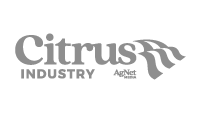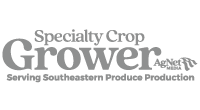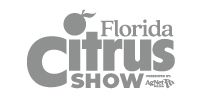By Fernando Alferez, Divya Aryal and Saoussen Ben Abdallah
In the last few years, the University of Florida Institute of Food and Agricultural Sciences (UF/IFAS) citrus horticulture team at the Southwest Florida Research and Education Center (SWFREC) in Immokalee has performed several research trials in commercial farms and at the experimental farm at the SWFREC to elucidate the effect of homobrassinolide on trees affected by HLB. The work has shown that homobrassinolide treatment may influence internal maturity in Hamlin and Valencia sweet oranges if performed at the right time. Also, this plant growth regulator (PGR) may delay HLB incidence in newly planted citrus trees by inducing salicylic acid-mediated immune response.
Homobrassinolide is a brasssinosteroid. Brassinosteroids (BRs) are a natural group of PGRs that regulate different physiological and biochemical processes. This includes seed germination, flower development, fruit maturation, root formation and resistance to various abiotic and biotic stresses. BR research on citrus was scarce when UF/IFAS initiated this work, but some results were promising. This article summarizes the most important findings in the studies.
APPLICATION TIMING IS KEY
Treatment of 6.2 fluid ounces of BR per 100 gallons of water applied once by foliar spray at the right time of fruit maturation has the most consistent results influencing internal maturity in Hamlin and Valencia sweet oranges. The rate used was determined in several dose-response trials, using 10 times less and 10 times more active ingredient. While using 10 times less active ingredient had some mild effects, especially on tree growth, using 10 times more than 6.2 ounces did not add any additional benefit. For mature trees that are 7 or more years old, 1 gallon per tree of the prepared solution is typically used for full coverage.
In Hamlin, significant differences in Brix were seen when treatments are performed in a time window between mid-November and mid-December, with harvesting occurring two weeks after treatment. This was coincident with peel color change in this variety and when acidity in juice naturally started to decline. In these conditions, Brix increased from 7.9 (control) to 8.9 (BR-treated trees).
In Valencia, the window of efficacy for this PGR is different. PGRs usually have very narrow windows of efficacy that depend on the physiological status of the plant organ (in this case, the fruit) to be treated. Targeting the fruit at the right maturation stage will produce the desired effect of the PGR. As Valencia oranges take longer to develop and mature, the time for treatment is different. Applying BRs before February did not make any difference in Brix or in the sugar-to-acid ratio. However, starting in mid-February, a mild increase in Brix occurred. By March, Brix in fruit from BR-treated trees was 9.4 as compared to 8.5 in non-treated controls.
Interestingly, researchers also saw a more pronounced decrease in titratable acidity after BR treatment as compared to controls. As a result, the sugar-to-acid ratio in the BR-treated fruit was 10.5 as compared to 7.9 in the controls.
TREE HEALTH AND BR RESPONSE
In both Hamlin and Valencia, trees in better shape responded better to the treatments. Using a tree health scale from 0 (healthy looking trees with a dense canopy) to 5 (abundant limb dieback, scarce canopy with small leaves and blotchy mottle symptoms present), better, more consistent results were seen in trees ranking 2 to 3. Researchers were not able to find any trees ranking at 0 or 1. A score of 2 to 3 is consistent with trees that are still retaining a dense canopy and show no twig dieback.
Ongoing research is determining the effect of BRs on trees that are being treated with oxytetracycline. It is expected that better tree health will result in better response to BRs. New research plots at a commercial farm have all trees ranked at 1 and 2 in the tree health score, so researchers are confident they will be able to measure a more significant effect on internal fruit quality when applying BRs.
BENEFITS TO YOUNG TREES
BRs applied once per month to newly planted trees at the rate of 6.2 fluid ounces/100 gallons of water by foliar spray significantly delay HLB disease development, protecting trees for several months as compared to non-treated trees. Candidatus Liberibacter asiaticushas not been detected for up to six months when treating young trees with BRs from the time of planting. Eventually, the trees become HLB-positive, but there is a clear delay in infection.

While application of BRs once per month is the ideal frequency, application of this PGR every 45 days also protects the trees. The protection is due to an induction of a strong immune response by activating several key genes in the salicylic acid pathway. This response is at a maximum 30 days after treatment but is still significantly high by 45 days before it begins to decline.
BR treatment also reduced psyllid colonization in new flushes and significantly reduced incidence of other pests such as rust mites in fruit-bearing trees.Some other effects of BR treatment on young citrus trees that were seen in UF/IFAS experiments included an increase in lateral branching, more feeder root growth, a denser root ball and more fruit set than in non-treated trees. Also, trunk diameter is larger with BR treatment (Figure 1).
TESTING FOR TREE RECOVERY
A recurrent question is: If trees were planted and left unprotected a couple of years ago and now are suffering from HLB infection with no fruit-bearing future ahead, can they be recovered and their health improved to the point that they can produce fruit? To answer this question, researchers started a trial at the SWFREC experimental farm last year.

Newly planted trees were left unprotected, so they became HLB-positive with time. After 12 months in the ground, half of the trees were covered with individual protective covers to avoid reinfection. BR treatment applied by foliar spray once a month was started to induce immune response in these trees and to see if tree growth would improve. Researchers have not yet seen a reduction in bacteria titer after six months. However, tree health clearly is improved, with larger canopies and more chlorophyll in leaves that are larger than in non-treated controls (Figure 2). This is an ongoing project, so researchers will be monitoring not only bacteria titer, but also tree growth and eventually fruit set and quality.
Acknowledgement: This research is supported with funding from the Citrus Research and Development Foundation (grants 22-003 and 24-001).
Fernando Alferez is an associate professor, Divya Aryal is a Ph.D. student, and Saoussen Ben Abdallah is a postdoctoral associate, all at the UF/IFAS SWFREC.
Share this Post
Sponsored Content










